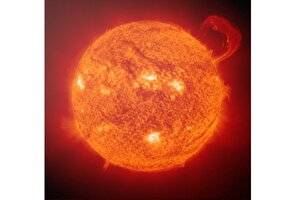One sunspot mystery solved, researchers say
Earth seems to warm up too much during sunspot activity. Now scientists say they've found where the extra energy is coming from.

The sun, seen through a powerful filter.
NEWSCOM/FILE
For some time, scientists have observed that sunspots seem to have an inordinate impact on earth's weather.
Sunspots are areas of intensified magnetic activity on the sun's surface. They occur roughly on an 11-year cycle. Right now, we're at the minimum of the cycle, and poised, most likely, to enter a phase of increased activity.
Here's the mystery when it comes to sunspots:
The small increase in energy emitted by the sun during solar maximums (the peak of sunspot activity) doesn't seem to match the higher temperatures observed on earth. During sunspot years, the sun's total energy output rises by just one-tenth of one percent. During those years, average sea surface temperatures increase by about 0.1 degrees C. But scientists calculate that, to get those higher temperatures, the amount of solar energy reaching earth would have to increase by about 0.5 Watts per square meter. And that's where observed reality refuses to align with scientists' number-crunching. During the peak of the sunspot cycle, the energy reaching Earth only increases by about 0.2 Watts per square meter – less than half what scientists think is necessary.
In short, Earth seems to warm up too much during solar maximums. Where is that extra energy coming from?
A new study appearing today in the journal Science offers an answer to this longstanding mystery. Two climate processes, one top-down and the other bottom-up, amplify the effects of increased solar activity, say the authors, raising temperatures beyond what you might expect. How do they know? With ever more powerful computers, scientists can run increasingly complex climate models. In this case, scientists at the National Center of Atmospheric Research took two existing models, neither of which was able to reproduce observed changes alone, and combined them. This "super" model includes more atmospheric layers than in the past, like the stratosphere, and allows for changes in atmospheric chemistry induced by solar radiation, both of which proved crucial to getting a result that approximated reality.
The scientists focused on the Pacific Ocean, which shows a strong response to periods of increased solar activity. And here's what they came up with:
First, more incoming solar radiation warms the stratosphere over the tropics. Warmer conditions, in turn, lead to the production of more ozone. More ozone causes more of the sun's incoming energy to be "caught" in the stratosphere. This feedback changes circulation patterns in the stratosphere.
The stratosphere is separated from the troposphere (the lower atmospheric layer where most weather happens) by the tropopause. So if the two layers are distinct, how does what happens up high affect what we experience down low?
Answer: by what scientists call "wave energy." The layers don't necessarily mix. Rather, just as waves travel and transmit energy through water without necessarily moving the water forward or backward, waves travel – and transmit energy – through different layers of the atmosphere. In this case, changes in stratospheric circulation affect the troposphere by reinforcing, through these energetic waves, certain wind patterns. These strengthened winds cause stormier conditions over the western Pacific.
Then there's the bottom-up component. At the equator, heated air rises. Once cooled, that air descends over the subtropics. Where the hot humid air rises and cools, you generally get storms and rainfall; where it sinks, you generally get clear skies and not much precipitation. (For this reason, many of the world's deserts occur at subtropical latitudes.)
During sunspot years, a little more energy hits the sea surface of the Pacific. The subtropics, which naturally have few clouds to reflect the sun's energy back into space, warm more than other areas as a consequence. That increases evaporation and water vapor. The westerly trade winds carry the extra moisture to the western tropical Pacific. More rain falls there. The entire cycle is reinforced.
The end result of these "top down" and "bottom up" processes working together: during solar maximum years, the subtropics are more cloudless than usual, and more sunlight – which is a little stronger – hits the ocean. That warms the ocean more than usual, raising the observed temperature. This increased warmth isn't evenly distributed: The trade winds are stronger than usual, too, making the eastern Pacific cooler, drier, and less stormy than usual. The western Pacific, meanwhile, gets more warm water and more rain. If that sounds familiar, that's because it mimics, very generally, the conditions that prevail during La Niña years.
Not everyone is persuaded that the study satisfactorily explains the sunspot-earth connection. A news article accompanying the Science study airs some scientists' doubts:
The study “is not nearly as conclusive as they would have it,” says Joanna Haigh of Imperial College London, who developed the top-down mechanism. Among additional critiques, she and others say the researchers ran the model too few times to give reliable results. “The atmosphere and oceans are a big coupled system,” she says, “but it’s incredibly complicated.”
For those wondering how the study bears on global warming, Gerald Meehl, lead author on the study, says that it doesn't – at least not directly. (For more on sunspots' possible role in global warming, see Monitor colleague Pete Spotts's article.
Global warming is a long-term trend, Dr. Meehl says in a phone conversation. By contrast, this study attempts to explain the processes behind a periodic occurrence. But, he says, a model finally able to reproduce a complex phenomenon observed in the real world does suggest that our climate models – the same ones we use to predict what will happen to global climate as we ratchet up CO2 concentrations – are improving. And that will, inevitably, have an effect on the climate discussion.
